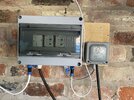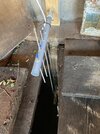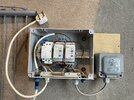The comparison between different ratings is not straightforward and seems to vary between different manufacturers. Not only that some manufacturers rating plate shows only current for AC1 but KW/HP for AC3 and then may only show for 400V/3 phase.Is it a 1.5kW pump, usually left for remote starting on just a float switch. The whole purpose of this exercise is to provide easier setting of hi and low levels, and to avoid potential for the float switch to get snagged. I intend this control box to simply power a socket on/off. It should result in fewer starts per hour than the float switch as we can then utilise the full depth of the sump.
My thinking here is that so long as the contactor itself is not the weak link then the overcurrent protection continues to be just as provided by the 13A fuse that will still be present on the pump plug (maybe10A, haven't checked). I need to leave the pump workable on any socket in case it needs moving location, so hard wiring is not an option.
If I did opt for additional protection in the panel then would a regular single pole MCB on the live just prior to the contactor do the job? I guess these are not as adjustable, but given it is a domestic pump without FLC data on the nameplate its going to be a bit of a guess what to set the overload to anyway, although I could measure actual current in operation.
On the contactor rating - can you shed any light on this rating below? This was my initial pick (cheap, available in Screwfix) before checking the spec. You see for AC-7b it is rated for 9A, but only 1.2kW. So I conclude this is not suitable for a 1.5 kW pump. Are AC3 specified contactors so different that when plated at 6A they are good for 1.5 kW of inductive load?
View attachment 322026
It's not always easy to identify what category a motor should be put into unless it's shown on the rating plate, for example a similar motor may be fitted in two different devices, although not a good example (for several reasons); think about the varying load on an electric drill compared to a sewing machine.
Working in controls for a few years soon got me into the swing of using AC3 figures for motors which meant frequently fitting a larger contactor than actually required.
Without knowing which category your pump fits in it's hard to say if AC7a or b
I'll be honest, I've only ever used a domestic contactor once and that was to override a 500W floodlights PIR so the question of rating of these have not arisen with me before.
A 1.5KW pump will be approximately 6.6A, once you have been able to establish the category your pump fits into the resolution will be quick. If it were me I'd be using a different contactor because that's what I use on a daily basis, I'm sorry I don't have the experience with things like the BG you show, I'm not in any way criticising as I don't know them.




